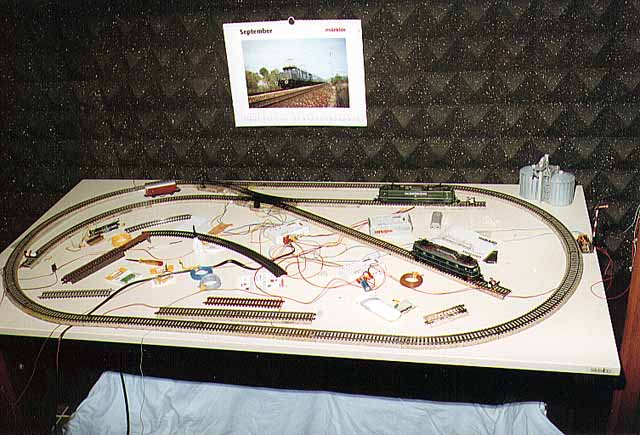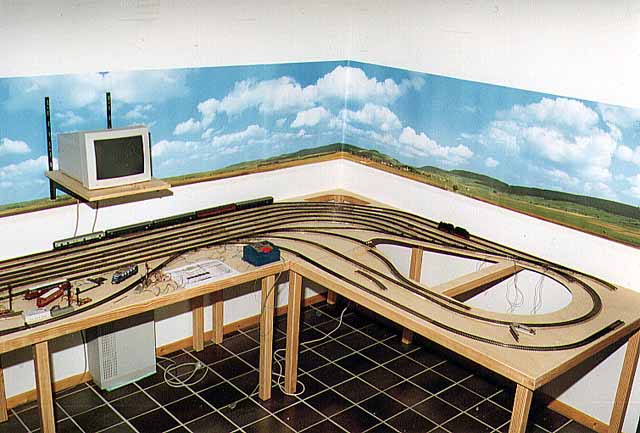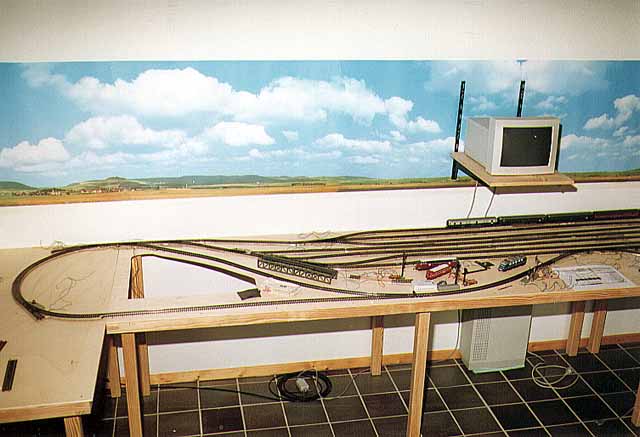The History of my Model Railway Setup
December 1996

After two decades and purely by chance, I once more got a Maerklin catalogue into my hands. I was immediately fascinated by the idea to combine my current hobby, computers, with the digital techniques of a model railway. Hence I purchased a Control Unit 6021 and a 6051 Interface and dug out my old M-Track. Since I had no idea, what a 6090-propulsion system meant, I also purchased a BR 151 (37431) and a BR 260 shunting locomotive with TELEX couplers, but with a simple 6080 decoder. The first test-setup occurred on a desk and from the beginning I controlled everything through an Apple Macintosh computer. I developed the necessary software myself. The first test runs clearly demonstrated the superiority of the controlled 6090 decoder. Reasonable shunting was not possible with the 260 and the decision was made to exclusively purchase 37xxx locomotives in the future.

A short while later, my model railway ambitions were no longer satisfied by the small test-oval and I planned a new setup (naturally on the computer). Accordingly the guestroom, approximately 4 x 4.5-m in size, was cleaned out and some reasonable illumination was installed. The lighting consists of four special fluorescent lights, which are the spectral equivalent of 75% of natural daylight. This assures realistic photographic detail. The two blue 100-Watt lamps in the center of the room can be used to simulate night lighting.

The base structure is not of the usual open frame construction, as is normal with most current setups. The reason for this is the shadow railway station (Schattenbahnhof) that is planned for the lowest level and requires a solid base plate. The plate itself consists of 8-mm plywood and is supported by a frame of 5 x 5-cm studs.

The setup is planned along the walls, so that everything can be viewed from the center of the room. Thus it is simple to install generous curves and long straight stretches. The size of the plates allows for easy access to the rear parts of the setup. The gap between the two "tables on the left will taken up by a "hanging" canyon and bridged with a small viaduct. The background (Faller 511 and 514) was installed right from the beginning and mounted so that it fits the third or top level of the setup. I decided for this slightly hilly landscape since, as a North German, I did not want an alpine setup.

Because, as previously mentioned, I want to control everything with the computer, I only require a keyboard and a mouse at the control position. All the other components, such as Control Unit, Interface, Booster and Transformers can thus be banished to the background. I place all of this in the remotest corner of the setup, where it does not interfere with anything. Expensive control elements, such as the Control 80f (6036), Keyboard (6040) or Memory (6043) are not required.

To avoid wasting space on the setup, the computer (Apple Macintosh Quadra 650 with a Power PC-card) was also placed on the floor. The monitor, a small 12 " unit with just 512 x 384 pixels, supplies an image that is well readable from larger distances. Two tracks were screwed onto the scenery background and a plate was mounted to the tracks. On this picture, the monitor is mounted quite low; later it will be placed approximately 30 cm above the uppermost level of the setup.

For the shadow railway station (Schattenbahnhof) I fetched my old M-Tracks from the attic. They should be good enough for the non-visible part of the setup. Any areas without tracks were cut out with a jigsaw, to allow for access in case of derailments. The black cable on the floor is the Ethernet connection to the computer in the living room. The control software is developed there, since it is easier to work on two 20" monitors.

I decided to use K-Track for all visible areas of the setup. Since applying ballast by hand was too much work, I tried pre-made ballast underlay from Merkur. The use of this material is very easy and it looks much more realistic than M- or C-Track. The Maerklin form signals were recessed into the base plate to hide the ugly actuators.








